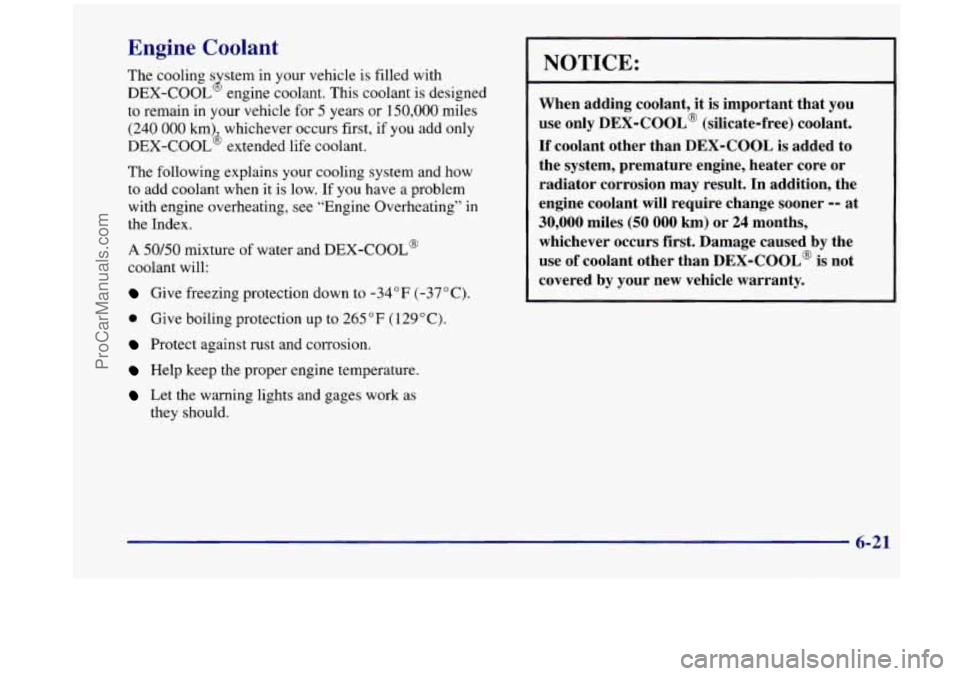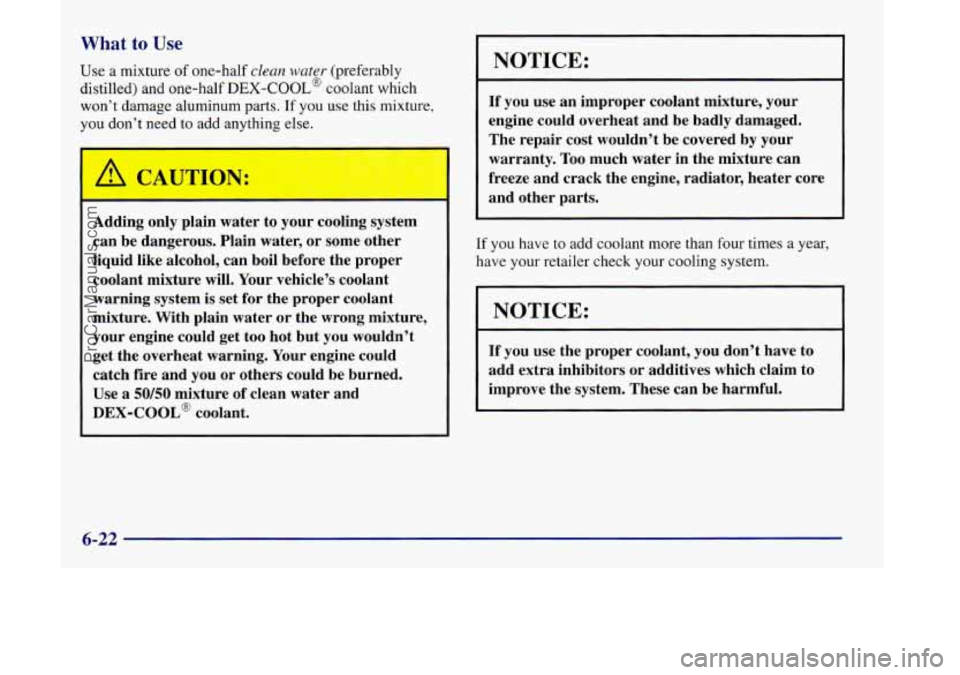Page 291 of 444
The coolant level should be at or above the
FULL COLD mark.
If it isn’t,
you may have a leak in the radiator hoses,
heater hoses, radiator, water pump or somewhere else in
the cooling system.
’ A CAUTION:
Heater and radiator hoses, and other engine
parts, can be
very hot. Don’t touch them. If you
do, you can be burned.
Don’t run the engine if there is a leak.
If you run
the engine,
it could lose all coolant. That could
cause an engine fire, and you could be burned.
Get any leak fixed before you drive the vehicle.
~
NOTICE:
Engine damage from running your engine
without coolant isn’t covered by your warranty.
If there seems to be no leak, with the engine on, check to
see if the electric engine cooling fans are running.
If the
engine
is overheating, both fans should be running. If
they aren’t, your vehicle needs service.
5-17
ProCarManuals.com
Page 292 of 444
IN:
How to Add Coolant to the Coolant
Recovery
Tank
If you haven’t found a problem yet, but the coolant
level isn’t at or above the FULL COLD mark, add a
50/50 mixture of clean water (preferably distilled) and
DEX-COOL@ engine coolant at the coolant recovery
tank.
(See “Engine Coolant” in the Index for
more information.)
- -
Adding only plain water to your cooling system
can be dangerous. Plain water, or some other
liquid like alcohol, can boil before the proper
coolant mixture will. Your vehicle’s coolant
warning system is set for the proper coolant
mixture. With plain water or the wrong mixture,
your engine could get too hot but you wouldn’t
get the overheat warning. Your engine could
catch fire and you or others could be burned.
Use
a 50/50 mixture of clean water and
DEX-COOL@ coolant.
NOTICE:
In cold weather, water can freeze and crack the
engine, radiator, heater core and other parts.
Use the recommended coolant and the proper
coolant mixture.
5-18
ProCarManuals.com
Page 331 of 444

Engine Coolant
The cooling s stem in your vehicle is filled with
DEX-COOL engine coolant. This coolant is designed
to remain in your vehicle for
5 years or 150,000 miles
(240 000 lunb whichever occurs first, if you add only
DEX-COOL extended life coolant.
J
The following explains your cooling system and how
to add coolant when it is low. If you have a problem
with engine overheating, see “Engine Overheating” in
the Index.
A 50/50 mixture of water and DEX-COOL@
coolant will:
Give freezing protection down to -34°F (-37°C).
0 Give boiling protection up to 265 OF (1 29 O C).
Protect against rust and corrosion.
Help keep the proper engine temperature.
Let the warning lights and gages work as
they should.
NOTICE:
When adding coolant, it is important that you
use only
DEX-COOL@ (silicate-free) coolant.
If coolant other than DEX-COOL is added to
the system, premature engine, heater core or
radiator corrosion may result. In addition, the
engine coolant will require change sooner
-- at
30,000 miles (50 000 km) or 24 months,
whichever occurs
first. Damage caused by the
use of coolant other than DEX-COOL@ is not
covered by your new vehicle warranty.
6-21
ProCarManuals.com
Page 332 of 444

What to Use
Use a mixture of one-half clean water (preferably
distilled) and one-half
DEX-COOL@ coolant which
won’t damage aluminum parts. If you use this mixture,
you don’t need to add anything else.
Adding only plain water to your cooling system
can be dangerous. Plain water, or some other
liquid like alcohol, can boil before the proper coolant mixture will. Your vehicle’s coolant
warning system is set for the proper coolant
mixture. With plain water or the wrong mixture,
your engine could get too hot but you wouldn’t
get the overheat warning. Your engine could
catch fire and you or others could be burned.
Use
a 50/50 mixture of clean water and
DEX-COOL@ coolant.
J
NOTICE:
If you use an improper coolant mixture, your
engine could overheat and be badly damaged.
The repair cost wouldn’t be covered by your
warranty. Too much water in the mixture can
freeze and crack the engine, radiator, heater core
and other parts.
If you have to add coolant more than four times a year,
have your retailer check your cooling system.
NOTICE:
If you use the proper coolant, you don’t have to
add extra inhibitors or additives which claim to
improve the system. These can be harmful.
6-22
ProCarManuals.com
Page 369 of 444

Fuses Fuses
RR HVAC SWC ACCY
HAZARD
RR PWR SCKT
DRL
LH T/LP
RR DEFOG
FRT PWR SCKT
SIR
FRT HVAC LOW/MED BLWR Rear
Blower Motor, Rear
Heater-A/C Control, and
Temperature Door
Actuator (Rear)
Steering Wheel Radio Control
Switches
Turn Signal Switch
Rear Electric Accessory
Plug Housing
DRL Control Module
Not Used
Rear Window Defogger Relay
Front Electric Accessory
Plug Housing
Inflatable Restraint
Control Module
Heater-A/C Control MALL/RADIO/DIC
BCM, Driver Information
Display, Radio and Radio Rear Speaker Amplifier
STOP LAMP
ABS MOD BATT
CAN VENT
SOL
ELC CTSY LAMP
IGN 1
Stoplamp Switch to Stoplamps
Electronic Brake Control
Module/Electronic Brake
Traction Control Module (EBCM/EBTCM)
Evaporative Emissions (EVAP)
Canister Vent Solonoid Valve
Electronic Level Control (ELC)
Air Compressor and ELC
Relay, Trailer Harness
BCM
ALC Sensor, BCM, Electronic
Brake Control Indicator Lamp
Driver Module, Instrument
Panel Cluster, Rear Window
Wipermasher and
Multifunction Switch (Fog
Lamp SwitcWTraction Control
Switch) and Stoplamp/Torque
Converter Clutch (TCC) Switch
6-59
ProCarManuals.com
Page 370 of 444
Fuses
SUNROOF
RR WPR WSHR Sunroof
Control Module
Rear Window Wiper Motor,
Rear Window Wipermasher
and Multifunction Switch (Rear
Window Wipermasher Switch)
LH HEADLP LOW Not
Used
LH HEADLP
HIGH
ABSITCS IGN
ABS
SOL
Not Used
Electronic Brake Control
Module/Electronic Brake
Traction Control Module (EBCMEBTCM)
LH and RH Front Brake
Solenoid Valve
Fuses
HVAC/DRL Air Inlet Actuator, DRL Control
Module, Heater-A/C Control,
Temperature Door Actuator (Front) and Rear Window
Defogger Relay
BCM PRGRM Body Control Module (BCM)
RH HEADLP LOW Not Used
RH HEADLP
HIGH
PCM Not
Used
IGN MAIN Relay and PCM
6-60
ProCarManuals.com
Page 373 of 444

Mini Fuse
2 1 -1GN 1 -UH
22-SPARE
23-SPARE
24-SPARE
25-ELEK
IGN
26-SPARE
27-B/U LAMP
28-NC CLU
29-RADIO Evaporative Emissions
(EVAP)
Canister Purge Valve, Heated
Oxygen Sensors
1 and 2, Mass
Air Flow (MAF) Sensor
Not Used
Not Used
Not Used
Ignition Control Module (ICM)
Not Used
Transaxle Range Switch to
Back-up Lamps
A/C CLU Relay to A/C
Compressor Clutch Oil
Driver Information Display,
Heater A/C Control, Radio,
Rear Side Door Actuator
Control Motor, Remote Control
Door Lock Receiver (RCDLR),
Security Indicator Lamp and
Theft Deterrent Shock Sensor
Mini Fuse
30-ALT SENSE
3
1 -TCC Generator
Automatic Transaxle
(Torque
Converter Clutch Solenoids)
Stoplamp Switch to PCM
32-FUEL PUMP Fuel Pump Relay
33-ECM SENSE
34
35-FOG LP
36-HORN
37-PARK LP
38
39
40 Powertrain Control
Module (PCM)
Not Used
Fog Lamp Relay
Horn Relay
Daytime Running Lamps (DRL) Control Module,
Headlamps and
I/P Dimmer
Switch Theft-Deterrent Relay
to Headlamps
Not Used
Not Used
Mini Fuse Puller
6-63
ProCarManuals.com
Page 374 of 444

Replacement Bulbs
Exterior Lamps Bulb Number
Headlamps ......................... 9004-HBI
Signal Lamps
.......... .3 157 NA or 3 157 NAK
Front Sidemarker Lamps ................... 194
Stop/Tail (Top)
.......................... 3057
Signal (2nd from top)
..................... 3 156
Tail (Bottom) ........................... 3057
Front Parking/Turn
Back-up Lamps (3rd from top)
............. 3156
Capacities and Specifications
The following approximate
capacities are given in
English and metric conversions.
Please refer to “Recommended Fluids and Lubricants’’
in the Index for more information.
Automatic Transaxle
Pan Removal and Replacement ..... 8 quarts (7.5 L)
With A/C
................... 9.6 quarts (9.1 L)
Cooling System
With Rear Climate Control
or Rear Heater
............ 1 1.9 quarts (1 1.3 L)
Engine Crankcase - Oil and
Fuel Capacity Filter Change
............... 4.5 quarts (4.3 L)
Standard/Regular .............. 20 gallons (76 L)
OptionalExtended
............ 25 gallons (95 L)
Refrigerant,
Air Conditioning*
.......... See the Refrigerant
Label under the hood.
Tire Pressures, Sizes ........... See Tire-Loading
Information label
on driver’s door.
Wheel Nut Torque .......... 100 lb-ft (140 N-m)
Windshield Washer Fluid ....... 1 gallon (0.37 L)
*See Air Conditioning Refrigerants later in this section.
NOTE: All capacities are approximate. When adding,
be sure to fill to the appropriate level, as recommended
in this manual.
Engine Specifications
Engine VIN Code ........................... E
Firing Order
...................... 1-2-3-4-5-6
EngineType
.............................. V6
Horsepower
............................. 180
Thermostat Temperature Specification
................... 195°F (91°C)
6-64
ProCarManuals.com